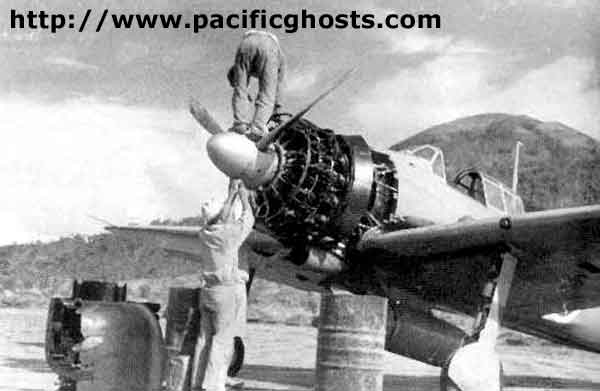Another day at Lakunai, halfway through 1942. Lakunai was Rabaul's primary fighter strip. It was heavily defended with AA guns, and searchlight units were detached at Raluana Point, near the Matupi causeway on the nearby beach, and on the hills in the Sulphur Creek area. The airfield itself was Y-shaped with both runways exceeding 4,500 feet. Despite volcanic dust which pervaded everywhere, the runways' coral surfaces were smooth and all-weather. At the Northeast end of both runways was a volcanic hill which constituted a formidable obstacle. Square protective revetments were placed alongside the runways, with most of the complex' buildings and barracks located at the southern field's end. Japanese maps and documents of the era refer to the field (in Kana) as 'Rabinjikku' - or 'Rabaul lower'. Vunakanau was known as 'Rabaul upper'. Lakunai was mostly used for smaller aircraft as the volcano you see here, and which so dominated the landscape, was considered dangerous for fully-loaded bombers to avoid.The desolate airfield with the native name of Lakunai was dusty from volcanic ash which emanated from an active volcano at the field's end. When the Tainan pilots first arrived at Rabaul by ship they were surprised to find an awaiting row of antiquated A5M 'Claude' fighters, not the familiar and beloved Zeros which they had been expecting. The antiquated Type 96 Claude fighters were assigned to the Chitose Kokutai. The Tainan Kokutai was gradually replenished with Zeros, the first six being assigned from carrier Shoho, and arriving in Rabaul on 17th February 1942.
In this photo an overall light grey A6M2 Zero fighter of the Tainan Kokutai is given routine servicing at Lakunai. This is the early part of the war - when groundcrew wore well-pressed clothes and caps - and hardships were few. The mechanic standing on the ground is undoing the self-tapping screws which held in the three-piece spinner, doubtless so that he can check the propellers constant speed unit. The one standing on top of the fuselage is probably working on one of the engine's fourteen cylinders. The two drums are to clamber onto the wings. Climbing onto the rear wing area was discouraged because of the thin skin surface there and the flaps. The two-piece matt black cowl lies on the ground ahead of them, easily removed by undoing the Dzus fasteners which held it together. The cowl was painted black to minimize reflection from harsh tropical sunlight. Volcanic dust at Lakunai played havoc with the engine's air filter which had to be regularly removed and cleaned. In overall terms however, the Zero was relatively easy to maintain, and despite its light airframe, robust. In the early parts of Rabaul's war spare parts were plentiful, and the fighters were kept highly tuned and serviced. As the war wore on, other aircraft were cannibalized to keep the remainder airborne.
